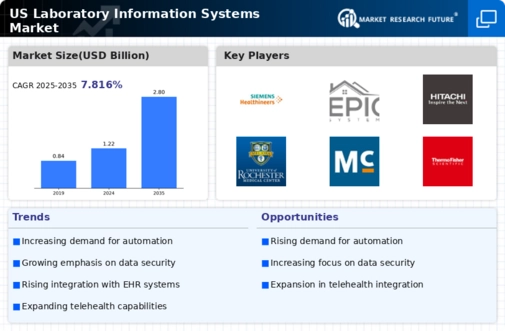Rising Demand for Automation
The laboratory information-systems market is experiencing a notable increase in demand for automation solutions. Laboratories are increasingly seeking to enhance efficiency and reduce human error through automated processes. This trend is driven by the need for faster turnaround times and improved accuracy in test results. According to recent data, the automation segment within the laboratory information-systems market is projected to grow at a CAGR of approximately 10% over the next five years. As laboratories adopt automated systems, they can streamline workflows, minimize manual intervention, and ultimately improve productivity. This shift towards automation not only enhances operational efficiency but also aligns with the broader trend of digital transformation in the healthcare sector.
Growing Focus on Patient-Centric Care
The shift towards patient-centric care is influencing the laboratory information-systems market. Healthcare providers are increasingly prioritizing patient engagement and personalized treatment plans, which necessitates the use of advanced information systems. These systems enable laboratories to provide timely and accurate test results, facilitating better communication between healthcare professionals and patients. As a result, laboratories are investing in solutions that enhance data accessibility and improve the overall patient experience. This trend is likely to drive growth in the laboratory information-systems market, as providers seek to leverage technology to meet the evolving expectations of patients and improve care delivery.
Regulatory Compliance and Quality Assurance
Regulatory compliance remains a critical driver for the laboratory information-systems market. Laboratories are required to adhere to stringent regulations set forth by governing bodies, which necessitates the implementation of robust information systems. These systems facilitate accurate data management, traceability, and reporting, ensuring that laboratories meet quality assurance standards. The market is witnessing a surge in demand for solutions that support compliance with regulations such as CLIA and CAP. As laboratories strive to maintain accreditation and avoid penalties, the laboratory information-systems market is likely to see continued growth in compliance-focused solutions. This emphasis on regulatory adherence not only safeguards patient safety but also enhances the credibility of laboratory operations.
Increased Investment in Healthcare Infrastructure
Investment in healthcare infrastructure is a significant driver of the laboratory information-systems market. As healthcare organizations expand their facilities and capabilities, there is a corresponding need for advanced laboratory information systems to support these developments. The U.S. healthcare sector is projected to invest over $200 billion in infrastructure improvements by 2027, which includes upgrading laboratory systems. This influx of capital is likely to enhance the capabilities of laboratories, enabling them to adopt more sophisticated information systems. Consequently, the laboratory information-systems market is expected to benefit from this trend, as healthcare providers seek to integrate cutting-edge technology into their operations to improve patient outcomes and operational efficiency.
Emergence of Advanced Analytics and Data Management
The laboratory information-systems market is witnessing a growing emphasis on advanced analytics and data management capabilities. Laboratories are increasingly recognizing the value of data-driven decision-making, which necessitates sophisticated information systems that can analyze and interpret large volumes of data. The integration of analytics tools within laboratory information systems allows for enhanced insights into operational performance and patient outcomes. This trend is supported by the increasing availability of big data technologies and machine learning algorithms. As laboratories strive to optimize their operations and improve diagnostic accuracy, the demand for advanced analytics solutions within the laboratory information-systems market is expected to rise, potentially reshaping the landscape of laboratory operations.

















Leave a Comment